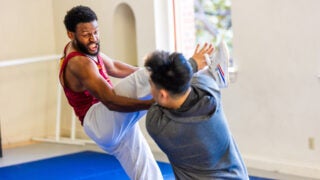USC schools bring diverse voices and perspectives into the classroom
University leaders describe their ongoing efforts to include more diversity in academia, re-imagining curriculums to bring in viewpoints that have historically been overlooked.
Frank Lloyd Wright’s harmonious designs and Frank Gehry’s whimsical creations are common topics of study in architecture programs. But what about the modernism movement in South America or sustainable building techniques invented by Indigenous people?
For many years, architecture and design students took classes from professors who focused on the Western European and American traditions in their academic careers. It’s been a critical part of their education, but faculty members at the USC School of Architecture want to broaden that narrow perspective, and they aren’t waiting for others to lead the way. They now emphasize the work of architects, landscape architects, heritage conservationists, scientists, sociologists and activists from around the globe in their courses to ensure their students recognize the contributions of previously marginalized groups.
The architecture program is only one example of a dramatic shift underway at the university. Schools across USC are re-imagining their curriculums to bring in diverse viewpoints historically excluded from academia.
At the Keck School of Medicine of USC, for example, future care professionals learn about the health impacts of various social issues, like health disparities linked to segregated housing policies or the impact of gun control on health systems. Students at the USC School of Cinematic Arts embrace difficult conversations about the film industry’s history, such as the historical significance of 1915’s The Birth of a Nation and problematic portrayals of racist stereotypes.
These changes go beyond rewriting a syllabus with more inclusivity in mind or introducing a few new classes. Curriculum changes are part of a much larger trend in USC schools to diversify their faculty, expand scholarship opportunities and offer more cross-disciplinary courses. The changes impact everything from how professors are trained to how USC graduates go on to impact their industries.
Professors and administrators see these efforts as advancing the university’s goal of producing well-rounded, socially conscious students who can succeed professionally. Here is how they are making it happen.
USC experts infuse diversity into the coursework
“I came in and was asked to work with colleagues to revamp and put together a new curriculum,” said Amelia Jones, vice dean of academics and research and chair of critical studies at the USC Roski School of Art and Design. “So, with my colleagues, we were able to move the curriculum to what I think is a radical decolonial approach.”
The school’s new approach, in the works since 2014, acknowledges that an American art education historically has focused on Western Europe and the United States while simultaneously exposing students to a more diverse array of artists and movements.
We really consider it a moral imperative to help students by thinking through a critical historical framework.
Amelia Jones
This shift doesn’t seek to ignore or erase the history of art in Western Europe and North America. Rather, it begins by teaching the history of art and design as a fundamentally Western construct. Then it ensures students are exposed to an expanded world of artists, traditions and movements that have traditionally been marginalized.
Students at USC Roski are also exposed to new ideas of what it means to be an artist. Art is no longer funded solely by wealthy patrons. Artists can pursue other opportunities through nonprofits, grants and even crowdsourcing. Those new funding mechanisms can give them the independence to work on projects with a social impact. And they learn that success can mean being featured in galleries, museums or private collections — but that’s only one measure of achievement.
“We really consider it a moral imperative to help students by thinking through a critical historical framework,” Jones said. “That encourages them to think critically of where they will position themselves within those structures of power.”
New curriculum aims to modernize the performing arts
At the USC School of Dramatic Arts, faculty members and students are having similar conversations.
“We were specifically aiming to decolonize the canon, by which I mean that we were having to really foreground other diverse BIPOC [Black, Indigenous and people of color] playwrights, texts, artists, scholars, directors and pedagogies to really integrate those voices and experiences,” said Anita Dashiell-Sparks, associate dean of equity, diversity and inclusion and co-head of undergraduate acting.
A big part of the change has been to break away from the traditional “studio system” of a dramatic arts education. That system, with the professor as head of the studio wielding unquestionable authority over students, can create unequal and dangerous power dynamics.
“All of that is being really reexamined and rebuilt,” Dashiell-Sparks said. “In some spaces, it has been long overdue because the old studio system’s culture, dynamics and practices have not really been a healthy and productive aspect of this work or actor training.”
Again, the goal isn’t to eliminate or censor traditional texts. Instead, USC leaders want students and faculty members to look at old texts through a new lens. For example, at the USC School of Cinematic Arts, some parts of the established canon have a questionable history.
“For a very long time, some of the very early films made by the people who created the language of cinema were made by people from another time and era — literally another century,” said Michael Renov, vice dean of academic affairs at the cinema school.
D. W. Griffith created the first blockbuster in 1915, but The Birth of a Nation is no longer screened in its entirety because of its potentially triggering material.
The film, shown at the White House by President Woodrow Wilson, portrays members of the Ku Klux Klan as heroes and features racist depictions of Black people. Rather than censoring that content, Renov sees the new curriculum as acknowledging the impact of these historical roots of cinema.
“We’re really thinking about how students feel and how these conversations land with students,” he said. “Our students have different needs and expectations, especially going through this last year after George Floyd’s murder. We understand the concerns of social justice and the need for reconciliation are so important that we have to have the right kinds of conversation in the classroom.”
Diversifying curriculums at USC means viewing ancient texts through new perspectives
Similarly, faculty members at the USC Dornsife College of Letters, Arts and Sciences are rethinking how they teach topics historically dominated by those in power, typically white men of European descent. This is particularly important when studying ancient texts.
Emily Hodgson Anderson, dean of undergraduate education at USC Dornsife, acknowledges the challenges regarding representation for those who teach courses featuring classical or early modern texts.
“If we want to include new voices that are specifically diverse voices as defined by contemporary terms, those voices very often did not survive those time periods,” she said. “We’ve got Homer, Aeschylus, Sophocles; we’ve got Sapphio [a female poet], but a lot of other voices have been lost.
“However, if you are teaching a text like the Odyssey, you can absolutely teach it through a lens of race or class relations, even as these concepts that looked different in 800 BCE than they do now.”
Students see equity as a norm and said: We don’t want to have one course on diversity.
Esther Margulies
Hodgson Anderson is also a member of the General Education Committee, which is encouraging professors to submit proposals for new interdisciplinary courses from across the university with a focus on sustainability and diversity.
“In the context of this new initiative, for example, we invite someone who already teaches a course on ‘Black Social Movements’ in our general education program and encourage them to partner with someone from environmental science,” Hodgson Anderson said. “So now we can present our students with a course that pairs a focus on sustainability with investigations into diversity, equity and inclusion.”
Because every undergraduate student takes general ed courses, they have a broad impact at USC, she added.
This conversation isn’t limited to liberal arts and creative fields. Leaders at the School of Architecture also strive to expand the canon.
“When you read the history of architecture or theory, it reflects a very small cross-section of the profession and academia because a select few were regarded as the most scholarly resources,” said Esther Margulies, diversity and inclusion liaison at the architecture school.
The school’s evolving curriculum challenges professors to use examples of more diverse designers and conservationists previously absent from the classroom. Now they look to Oakland, Detroit, Asia, South America and Africa for work that exemplifies social and environmental justice.
And the architecture school, like many others at USC, ensured students had a powerful voice in the process of reworking the curriculum.
“After the events of last summer, our students were incredibly well-organized and thoughtful and delivered a comprehensive list of recommendations,” Margulies said. “They were very intentional in their requests. Students see equity as a norm and said: We don’t want to have one course on diversity. We want all courses to be more inclusive, diverse and equitable.”



